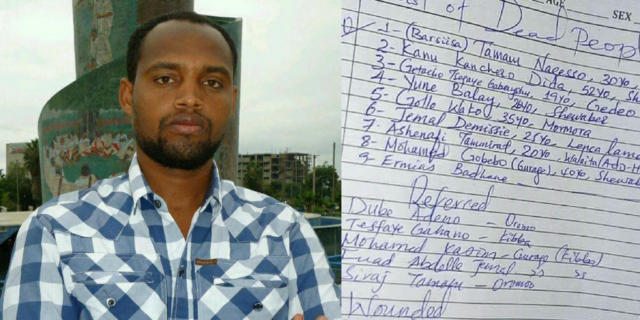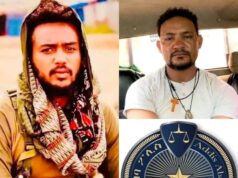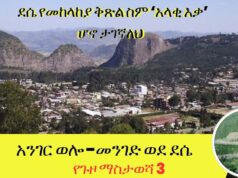Liyat Fekade /AS/
Addis Abeba March 11/2018 – At least nine civilians were shot to death on Saturday March 10 by members of the Ethiopian army in Moyale town, 790 km south of Addis Abeba, on the border between Ethiopia and Kenya. More than fifteen were also wounded, four of them critically.
Members of the army responsible for the killing were operating under the supervision of the command post established to oversee the current state of emergency. In a statement published on the state run EBC, the command post secretariat, led by defense minister Siraj Fegessa, said the killing happened when five members of the army acted based on a “mistaken intelligence report.” It also said the army was pursuing members of the banned Oromo Liberation Front (OLF), who “crossed in to the Ethiopian side.” The statement offered no details but said five members of the army were disarmed and are under investigations.
But since yesterday, Addis Standard spoke to three residents in the town, including a nurse who said the wounded included those who were “shot from the back and from close range”. None of the interviewees know what exactly triggered the killing. “Moyale was like every Saturday,” said Aliyi Abubakar, a friend of Temam Negeso, one of the victims who was a “school principal” in the city’s state run high school. But Temam is described in the list carrying the names of the victims as “teacher.” “Suddenly we started hearing deafening gun shots from the area called ‘Ashewa Tera.’ The shooting then spread to other areas in the city,” Aliyi said, “all we saw were dead bodies littered in the streets.” Aliyi described Temam as “good man who was closely attached to his students and the community. I came to know him a few months ago during a wedding of a mutual friend and since then we kept good contact. He didn’t deserve this. How are his students going to react to such news?”, Aliyi asked.
Left: A picture of Temam as was sent by Aliyi to Addis Standard. Right: List of victims released by the hospital. Temam’s name is mentioned under No. 1 (Barsiisa “Teacher” Tamam Negesso). There is also a spelling difference as Temam’s name is spelled in Qubee, the Afaan Oromo Alphabet
According to an assistant nurse at Moyale general hospital who wanted to remain anonymous, nine bodies were brought to the hospital between approximately 12 pm and 3 pm local time yesterday. Twelve others who sustained injuries from gun shots were also brought to the hospital. “Four of them were wounded critically,” Ayallo said. They were sent to Hawassa hospital, 515 km north of Moyale and at least eight hours of drive. “Six of the nine bodies were shot multiple times; and all of them were shot around or above their shoulders,” Ayallo added, “I am shocked as are my colleagues. Most of us are not trained to handle situations like this.”
Ayallo Huluka, another resident of the town gave his account saying the army brought an enforcement from a nearby military camp when residents “started running around in fear after the killing of the first victim.” “There was a lot of confusion and chaos. People were running around in all directions not knowing where to go. I have seen mothers scooping their kids and running away,” he said. “It was a pure carnage and no one knows what brought this to the town.”Ayallo said as most residents in the town, he said he didn’t know how and why the first victim was shot. He also said residents of the town were crossing to the Kenya’s Moyale town across the border. “I have seen several Isuzu cars full of people volunteering to drive people out of the town; others are simply walking by foot.” During a second phone call this morning, Ayallo said the shootings have subsided but “we are terrified. The town is silent and those of us who are left are still in shock.”
Graphic pictures showing wrapped and unwrapped bodies of the victims were circulating on Ethiopian social media.
Aschalew Yohannes, the Mayor of Moyale, told the regional state’s media OBN that he didn’t know what caused the problem and that investigations were underway. Without providing further details Addisu Arega, communication bureau head of the Oromia regional state, confirmed the killings in his Facebook post and offered offered his condolences.
Uptick in civilian causalities
Ethiopia’s council of ministers have announced the current of state of emergency, the second in a year and half, one day after the unexpected resignation of Prime Minister Hailemariam Desalegn.
However, the announcement came under heavy criticism both from Ethiopia’s key ally, the US, which stated its strong disagreement, and by local opposition party members, activists, academicians and international rights organizations. Although to a lesser extent than the US, the state of emergency has also drawn widespread criticism and reservations from many of Ethiopia’s traditional western allies including the EU, The UK, Germany, Norway and Sweden.
Following protests in various parts of the country, especially in Oromia regional state, against the martial law, on Feb 27 the command post said its patience against what it called “anti-peace elements” has run out and it no longer tolerates any form of disruptions to public lives; it also said it instructed security forces “to take all necessary measures to restore peace.”
Since then however there has been an uptick in civilian causalities and an increase in crackdown by the members of the command post against middle level bureaucrats within the Oromia regional state. Unknown numbers of individuals are detained so far including the chief administrator of east Hararghe zone, deputy administrator of east Wellega zone, the Mayor of Nekemt and head of the justice bureau of Kelem Wellega Woreda, as per this report.
The controversial state of emergency was legislated by the national parliament on Friday March 02 but it faced unprecedented objection from the OPDO members of the parliament. Many consider the move as part of the federal government’s attempt to crackdown on the new leadership of the OPDO, a sign of the deepening fracture among Ethiopia’s ruling coalition, EPRDF.
On March 07, Siraj Fegessa accused the Oromia-wide market boycott protests called by online activists to protest against the martial law as having a form of “color revolution” and an “attempt to seize state power” by those who are instigating the protests.

























The residents from where the victims are from are telling a different story. These residents know better how the ‘seeyaasaa of the regime has been playing out in the areas of their domiciles. There should not be any measurable OLF presence to worry about in the area. They are, for the most part, wandering around the deserts of Eritrea. Yes there may be some waging a liberation war against Kenya. Its leaders have lined up their pockets with the assistance money they managed to secure in the name of my people. They are filthy rich now. That is called the ‘Liberation of Oromia’ accomplished. My hunch is that these victims are well targeted by the regime because the spokesman did not take him too long to come up with this spiel to tell it was all a mistake. Even it was a mistake, it is committed by Marxist-Maoist demons who never learn from mistakes. It is not 2005, mister!!! The youth of both Oromia and Amhara are smarter than their predecessors and they have vowed not to never back down.
A mistake? Come on man!!! This is a human life put together so intricately by The Almighty Our Creator The Merciful. Human life is not something you brutally sniff it out and say ‘well so what? I made a mistake and I am entitled to make any mistake including this’. No sir!!! This is not a mistake but a crime against humanity. One human life is too many but a mistake with 9 human lives? But what should be expected from Marxis goons who have a history of killing prisoners of war and individuals who were doing humanitarian work during a raging famine in the 1980’s. A mistake!!! My foot!!! Shut up!!!